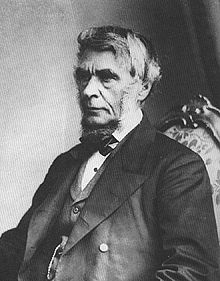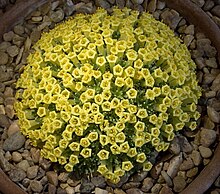George Bentham
George Bentham | |
|---|---|
 | |
| Born | 22 September 1800 Stoke Damerel, Plymouth, England |
| Died | 10 September 1884 (aged 83) London, England |
| Spouse | Sarah Jones |
| Awards | Royal Medal of the Royal Society in 1859 Clarke Medal of the Royal Society of New South Wales in 1879 |
| Scientific career | |
| Fields | Botany |
| Institutions | Royal Botanic Gardens, Kew |
| Author abbrev. (botany) | Benth. |
George Bentham
Life
Bentham was born in
While studying at
In 1832, he inherited the property of his uncle, Jeremy Bentham. Having inherited his father's estate the previous year, he was now sufficiently well off to do whatever he wanted, which was botany, jurisprudence and logic.[7]
Bentham married Sarah Jones (1798–1881), daughter of
Bentham died at his London home on 10 September 1884, aged 83.[3] He was interred in Brompton Cemetery.
Career
Views on evolution
Bentham's life spanned the Darwinian revolution, and his young colleague
Honours and awards
Bentham was awarded the Royal Medal of the Royal Society in 1859 and elected a Fellow in 1862.[11] He served as president of the Linnean Society of London from 1861 to 1874.[12] He was elected a Foreign Honorary Member of the American Academy of Arts and Sciences in 1866.[13] He was appointed CMG (Companion of St Michael & St George) in 1878. His foreign awards included the Clarke Medal of the Royal Society of New South Wales in 1879.
Works
Bentham's first publication was his Catalogue des plantes indigènes des Pyrénées et du Bas Languedoc (Paris 1826), the result of a careful exploration of the
In 1836 he published his Labiatarum genera et species. In preparing this work he visited, between 1830 and 1834, every European herbarium, several more than once. The following winter was passed in
In 1844, he provided the botanical descriptions for The Botany of the Voyage of H.M.S. Sulphur.
In 1854 he found the maintenance of a herbarium and library too expensive. He, therefore, offered them to the government on the understanding that they should form the foundation of such necessary aids to research in the Royal Botanic Gardens, Kew. At the same time, he contemplated the abandonment of botanical work. However, he yielded to the persuasion of Sir William Jackson Hooker, John Lindley and other scientific friends. In 1855 he took up his residence in London, and worked at Kew for five days a week, with a brief summer holiday, from this time onwards until the end of his life.[15]
In 1857, the government sanctioned a scheme for the preparation of a series of Floras or descriptions in the English language of the indigenous plants of British colonies and possessions. Bentham began with the Flora Hongkongensis in 1861, which was the first comprehensive work on any part of the little-known flora of China and Hong Kong, including
Selected publications
- "On the Distribution of the Monocotyledonous Orders into Primary Groups, more especially in reference to the Australian Flora, with notes on some points of Terminology". Journal of the Linnean Society of London, Botany. 15 (88): 490–520. February 1877. .
- Genera plantarum ad exemplaria imprimis in herbariis kewensibus servata definita (3 vols.). London: L Reeve & Co. 1862–1883.
- Outline of a New System of Logic: With a Critical Examination of Dr. Whately's "Elements of Logic. London: Hunt and Clarke. 1827. ISBN 9780598395641.
- The Botany of the Voyage of H.M.S. Sulphur. under Captain Ed. Belcher The Botanical descriptions by George Bentham: Text. Lords Commissioners of the Admiralty. 1846 – via Smith Elder and Co.
Legacy

The following plants have been named in his honour:
Genera
Species
- Acanthocephalus benthamianus Regel
- Andropogon benthamianus Steud.
- Gardenia benthamianus F.Muell.
- Croton benthamianus Müll.Arg.
- Distemonanthus benthamianus Baill.
- Triana) Pipoly
- Nicotiana benthamiana Domin
- Pinus ponderosa ssp. benthamiana Hartw.
- Thelymitra benthamiana Rchb.f.
- Verbascum sinaiticum
See also
- Bentham & Hooker system – System of plant classification by Bentham and Hooker
- Bentham's taxonomic arrangement of Adenanthos– Genus in plant family Proteaceae
- Bentham's taxonomic arrangement of Banksia – 1870 arrangement of the Australian endemic plant genus Banksia
- Category:Taxa named by George Bentham
Notes and references
Notes
Citations
- ^ Isely 2002, pp. 163–166.
- ^ Anon 1999, p. 43.
- ^ a b Amigo 2017, p. [page needed]
- ^ Shteir 1984, p. 71.
- ^ a b Thiselton-Dyer 1911, p. 746.
- ^ Cribb 2010, pp. 183–184.
- ^ Thiselton-Dyer 1911, pp. 746–747.
- ^ Burke 1906, p. [page needed].
- ^ Green 1914, p. 498.
- ^ Green 1914, p. 499.
- ^ Proceedings of the Royal Society of London 1885, p. i–v.
- ^ Botanical Gazette 1885, pp. 211–213.
- ^ American Academy of Arts and Sciences 2006, p. 40.
- ^ Bentham 1827.
- ^ a b c d Thiselton-Dyer 1911, p. 747.
- ^ Bentham 1846.
- ^ Plarr & Royal College of Surgeons of England 2006, RCS: E002231.
- ^ Bentham & Hooker 1862–1883.
- ^ International Plant Names Index. Benth.
Sources
- American Academy of Arts and Sciences (2006). "B". Book of Members: 1780-2005 (PDF). Cambridge, MA: American Academy of Arts and Sciences. OCLC 70224250. Archived from the original(PDF) on 23 November 2018.
- Amigo, Jean-Jacques (2017). "Bentham (George)". Nouveau Dictionnaire de biographies roussillonnaises (1789-2017) [New Dictionary of Roussillon biographies (1789-2017)] (in French). Vol. 3, Sciences de la Vie et de la Terre. Perpignan: Publications de l'olivier. OCLC 1012939774.[page needed]
- Anon (1999). A Dictionary of Scientists. Oxford: University Press. ISBN 978-0-19-280086-2.
- Bettany, George Thomas (1885). . In Stephen, Leslie (ed.). Dictionary of National Biography. Vol. 4. London: Smith, Elder & Co.
- OCLC 1336190250.
- Cribb, Phillip (12 December 2010). "The orchid collections and illustrations of Consul Friedrich C. Lehmann". Lankesteriana. 10 (2–3). Biographies. ISSN 2215-2067.
- "George Bentham". Botanical Gazette. 10 (1): 211–213. 1885. JSTOR 2994865.
- Green, Joseph Reynolds (1914). A History of Botany in the United Kingdom from the Earliest Times to the End of the 19th Century. London: J. M. Dent & sons.
- Isely, Duane (2002). One Hundred and One Botanists. Purdue University Press. ISBN 978-1-55753-283-1.
- "Obituary notices of fellows deceased". Proceedings of the Royal Society of London. 38 (235–238). 1885. ISSN 0370-1662.
- OCLC 646581474.
- Shteir, Ann B. (1984). "6. Linnaeus's Daughters: Women and British Botany". In Harris, Barbara J.; McNamara, Jo Ann (eds.). Women and the structure of society : selected research from the Fifth Berkshire Conference on the History of Women. Durham, N.C.: Duke University Press. pp. 66–73. OCLC 988155630– via Internet Archive.
- Thiselton-Dyer, William Turner (1911). . In Chisholm, Hugh (ed.). Encyclopædia Britannica. Vol. 3 (11th ed.). Cambridge University Press. pp. 746–747.
Further reading
- Jackson, Benjamin Daydon (1906). George Bentham. J.M. Dent. & Company.
- Bentham, George (1997). Filipuik, Marion (ed.). George Bentham: Autobiography, 1800-1834. University of Toronto Press. ISBN 978-0-8020-0791-9.
- Bentham, George (1839–1857). Plantas Hartwegianas.
External links
- Works by or about George Bentham at Internet Archive
- "Bentham, George" at Botanicus Missouri Botanical Garden Library
